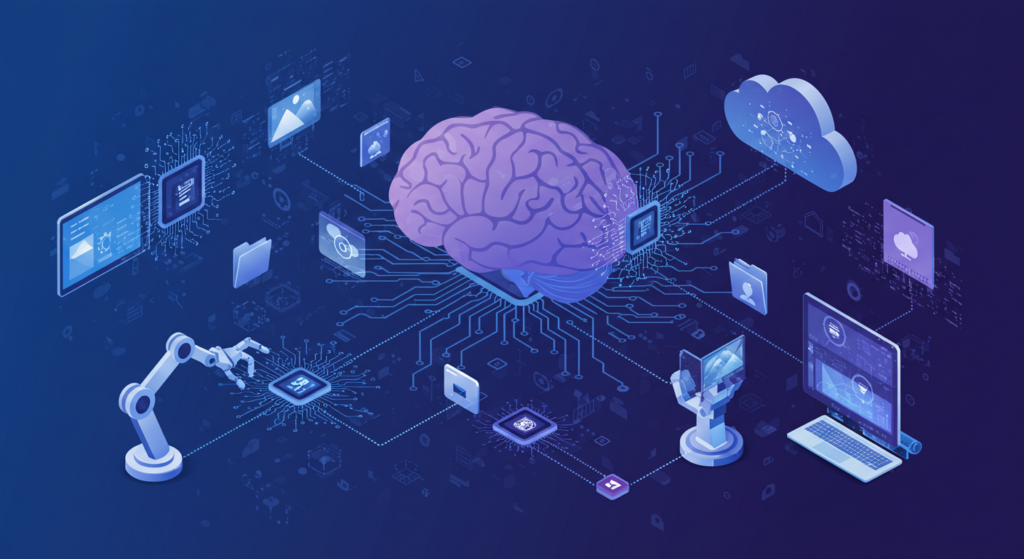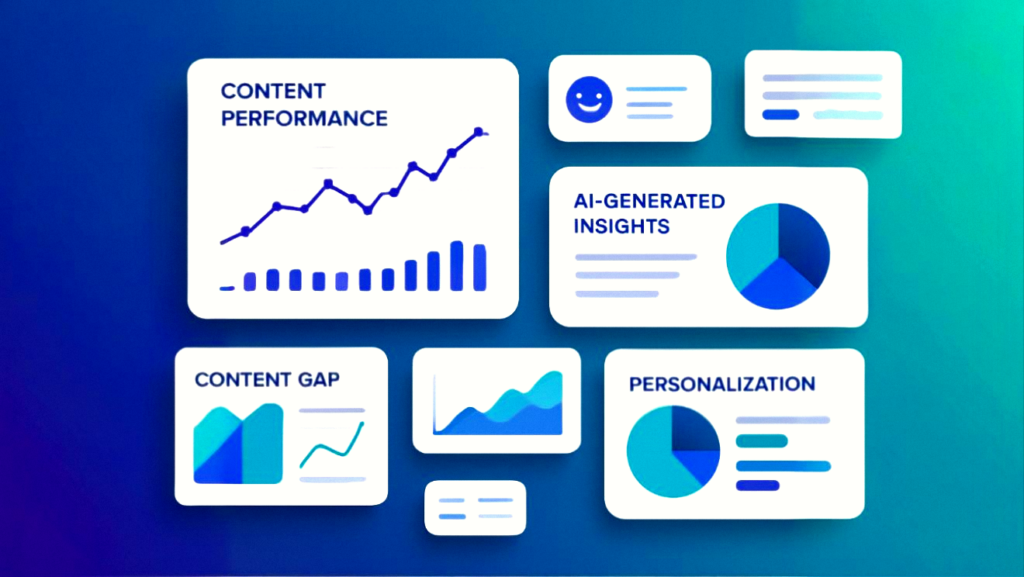The era of hunting through endless file folders for the right creative asset is officially over. With the digital asset management market growing at 14% annually and 78% of businesses embracing digital transformation initiatives, marketing teams can no longer afford outdated content management processes. Modern cloud digital asset management platforms are now intelligent, AI-powered ecosystems that automate workflows, predict content needs, and deliver personalized experiences at scale.
Today’s leading cloud DAM systems leverage artificial intelligence to transform how organizations create, organize, and deploy digital content. From predictive metadata that automatically tags and categorizes assets to AI agents that generate personalized content variations, these platforms eliminate manual bottlenecks while enabling real-time content personalization that drives measurable business results. Companies implementing AI-driven personalization strategies report up to 40% increases in revenue.
If your organization still relies on traditional file-sharing systems or basic cloud storage for content operations, the gap between your current capabilities and market leaders is widening daily. Discover how cloud digital asset management platforms are revolutionizing content workflows through AI automation, seamless collaboration, and intelligent personalization that scales with your business growth.
What Is a Digital Asset Management System?
Before diving into the benefits and features of a cloud-based digital asset management system, let’s start with the basics. What is digital asset management?
DAM, or digital asset management, is both a process and a system. Traditionally, it refers to the process of managing digital assets — branded content, images, video, logos, formal documents, and so on — through on-premise storage, email, content management systems, and other platforms. Storing digital content across a variety of platforms can get messy and risky. That’s where DAM solutions come in.
DAM systems can be either cloud-based or set up locally (on-premise). With the help of a DAM provider, your system provides a secure centralized library to store, organize, retrieve, and collaborate on all media types. The goals of optimized DAM are fewer roadblocks and miscommunications, leading to a more efficient, productive workflow. Enterprise DAM systems are primarily used by marketing teams but can support company-wide operations.
What Is Cloud-Based Digital Asset Management?
Now that you understand the digital asset management definition, let’s get into the specifics of cloud DAM. A cloud DAM (CDAM) system is a set of SaaS solutions that enable organizations to store, manage, search for, and share assets of all types without on-premise hardware. CDAM systems allow users all over the world to access an organization’s digital asset library.

With a modern, cloud-native DAM system, users move beyond just storing digital files. The centralized repository allows you to search for the files you need using metadata and contextual search functionality. It also supports easier collaboration and helps team members track progress, expediting your content operations.
Cloud-based solutions are perfect for remote teams or organizations that collaborate with external stakeholders. They can also support growing businesses with limited resources for on-premise digital asset management.
To sum it up, a great CDAM solution is:
- Cloud-based
- Designed to optimize your digital asset management strategy
- Used to make content ops more efficient
- Secure
- User-friendly
- Remotely accessible to internal and external team members
How Is Cloud DAM Different From On-Premise?
On-premise DAM solutions require dedicated servers and infrastructure for storing files. This becomes wasteful and inefficient as an organization’s content ops grows. A cloud DAM system, on the other hand, provides a secure, cloud-based platform to store and manage digital assets. It also offers automation tools for backups, version control, content delivery, and more.
Other differences between cloud and on-premise digital asset management systems include:
- Maintenance: Maintenance and technical support are typically included with a CDAM solution, whereas maintaining an on-premise DAM system falls to an organization’s IT team.
- Fees: Cloud solutions are generally more affordable than on-premise solutions.
- Transition: On-premise DAM requires a lengthy IT installation process. CDAM is easy to set up and requires minimal training.
- Device compatibility: CDAM systems can be accessed from any mobile or desktop device. On-premise DAM requires the use of approved on-site devices.
- Offline access: On-premise systems can be used offline, but only at the office. CDAM systems can be accessed anywhere there is an internet connection.
- Shareability: Assets stored in a CDAM system can be shared, with limited permissions, to external partners and stakeholders. On-premise systems are only accessible to approved internal users.
Who Is Cloud-Based Digital Asset Management Right For?
Every organization has its own unique structure and needs. It’s impossible to say that one software solution is right for everyone; however, cloud-based DAM is a fairly universal tool that will benefit businesses in many industries.
Examples of teams that will get the most benefit out of a CDAM solution include:
- Creative marketing agencies
- Financial services
- Non-profit organizations
- Healthcare organizations
- Legal professionals
- Real estate agencies
- Publishing companies
If public promotion or document management is an important aspect of your business, you will benefit from a solid cloud-based DAM system.
AI-Powered Cloud DAM: The Future is Now
The landscape of cloud digital asset management has undergone a revolutionary transformation. What started as digital storage solutions has evolved into intelligent content operations platforms powered by artificial intelligence and machine learning. Modern cloud DAM systems function as cognitive assistants that understand, predict, and automate content workflows in ways that seemed impossible just a few years ago.
Leading cloud-based DAM software platforms now deploy AI agents that handle everything from content creation to compliance checking. These intelligent assistants work around the clock to enrich assets with predictive metadata, automatically generate content variations for different channels, and flag potential brand compliance issues before they reach market. The result is a scalable DAM solution that actively optimizes and enhances your content.

AI-powered cloud DAM platforms have cracked the code on real-time content personalization. By analyzing user behavior patterns and content performance data, these systems can instantly determine which assets will resonate most with specific audience segments. This capability transforms static content libraries into dynamic, responsive ecosystems that adapt to customer needs in milliseconds rather than months.
The market has taken notice of this AI-driven transformation. The global digital asset management market is projected to reach $16.18 billion by 2032, with cloud-based solutions driving much of this growth. Leading companies implementing AI-enhanced cloud DAM report significant operational improvements, with some achieving productivity gains of up to 73% and asset creation speeds that are 49% faster than traditional workflows. These measurable improvements demonstrate that AI-powered cloud DAM systems deliver tangible business value beyond simple storage and organization.
The merger of cloud infrastructure and artificial intelligence has created what industry analysts call “intelligent content operations.” Instead of marketers spending hours tagging assets or searching for the right creative, AI handles the heavy lifting while human creativity focuses on strategy and innovation.
Benefits of a Cloud Digital Asset Management Solution
When it comes to choosing between CDAM and on-premise solutions, there are pros and cons to each. However, cloud solutions offer several benefits for businesses of all sizes. The ease of use, affordability, and remote compatibility of CDAM make it a great fit for most organizations.
Here are a few of the most significant benefits of moving to a cloud-based DAM solution:
Remote Accessibility
One of the biggest differences between CDAM and on-premise DAM is remote access. These days, as much as 73% of marketing collaboration happens remotely. Even teams that share an office space often collaborate with freelancers and external agencies or take advantage of hybrid work schedules. A cloud-based DAM solution allows secure access to shared projects from any location. This also gives creative teams more options when it comes to hiring and outsourcing.
Scalability
The user volume, fees, and features of a great CDAM system can be easily adjusted to meet an organization’s changing needs. In other words, cloud DAM grows with your business. You don’t have to overinvest in features you don’t need or deal with an enterprise DAM system that’s too limited for your content operations.
Flexibility
CDAM offers more flexibility than on-premise DAM solutions. Users can make changes to the system quickly and easily, with little downtime or disruption. Cloud-based systems also include the benefit of customer service and technical support. Your DAM provider can instantly make changes to the system without extensive IT processes.
Security
One of the most significant benefits of digital asset management, either cloud-based or on-premise, is increased security. The average cost of a data breach was nearly $5 million as of 2024. DAM software secures your most important digital assets, providing controlled access and preventing leaks.
Cloud-based systems can add even more security to your DAM strategy because CDAM’s remote accessibility encourages team members to exclusively use the system rather than downloading projects onto their personal devices to take their work home.
Cost Savings
CDAM is a more affordable alternative to on-premise DAM. It eliminates intensive hardware requirements since a cloud-based service doesn’t need dedicated servers and IT staff. Companies can reduce their total cost of ownership by 40% by migrating to the cloud.
Resilience
Change is a constant in the marketing world. Trends come and go, technology adapts, and new opportunities constantly present themselves. CDAM is one way to make your marketing team more resilient to change. The best CDAM platforms offer tons of integrations to work with new apps, and remote access makes it easy to adjust when you need to add new team members.
Reduced IT Burden
Running an on-premise solution for DAM is resource-intensive. This includes the IT staff resources needed to set up, troubleshoot, and maintain physical servers. A cloud-based solution takes this burden off their shoulders to free up time for more valuable activities.
Features to Look for in Cloud Digital Asset Management Software
Modern digital asset management tools offer a wide range of features to streamline and organize your content operations. While no two platforms are the same, the best DAM software offers many of these features in one place. Here are a few helpful features you’ll want to look for when comparing CDAM systems.
Format-Agnostic Storage
The right DAM software can accommodate all file types, such as images, videos, audio files, text, and other digital media. This creates a single source for your entire digital asset portfolio — you won’t need to switch between platforms when working with different media types.
Ease of Use
Look for a platform with a stable, intuitive user interface. Your CDAM system should be easy to learn and adjust to. That way, you can easily add new team members without extensive training. A free demo is a great way to make sure your prospective system is clear and intuitive, with accessible features like AI assistance and brand guidelines.
Customization
With a stand-alone DAM system, you have the power to create the ecosystem that best suits your needs. Look for a platform with customizable features, including adaptable brand templates and smart personalization. Responsive customer service is also a helpful asset when you need to make changes to your system.
Seamless Collaboration
Marketing campaigns rely on large teams to deliver an omnichannel experience. With so many moving parts in a campaign, communication is essential to a smooth process. Look for a solution that provides communication and collaboration features in-platform. Your chosen DAM provider should also offer collaboration features to ensure brand compliance.
AI-Powered Automation Capabilities
Modern cloud digital asset management platforms should leverage artificial intelligence to eliminate manual content management tasks. Look for systems that offer predictive metadata generation, which automatically tags and categorizes assets upon upload using computer vision and machine learning. The best platforms also include AI-driven content creation tools that can generate variations of existing assets, perform background removal, and create smart crops optimized for different channels. These automation features dramatically reduce the time teams spend on repetitive tasks while ensuring consistent, accurate asset organization across your entire digital library.
Content Personalization and Real-Time Decisions
Advanced cloud-based DAM software enables dynamic content experiences. Seek platforms that can analyze user behavior in real time and automatically serve the most relevant assets to different audience segments. Your DAM could integrate with your existing customer data platforms and content management systems to deliver personalized product recommendations, targeted landing page content, and channel-specific messaging. The right system should make content personalization decisions in milliseconds, ensuring every visitor receives tailored experiences that drive engagement and conversions.

Advanced Analytics and Content Intelligence
Your scalable DAM solution should provide deep insights into content performance and usage patterns. Look for platforms that track not just basic metrics like downloads and views but also measure content engagement across different channels, identify content gaps in your strategy, and provide recommendations for new asset creation.
The most sophisticated systems use machine learning to predict which content will perform best with specific audiences and automatically flag underutilized assets that could be repurposed. These intelligence capabilities transform your DAM from a passive storage system into an active strategic asset that guides content decisions and maximizes ROI.
Cloud Digital Asset Management FAQs
What makes AI-powered cloud DAM different from traditional digital asset management?
AI-powered cloud digital asset management platforms use artificial intelligence to automate content tagging, generate predictive metadata, and create personalized content experiences in real-time. Unlike traditional DAM systems that require manual organization, AI-enhanced platforms automatically categorize assets, suggest optimal content for specific audiences, and streamline workflows through intelligent automation.
How much does cloud-based DAM software typically cost for mid-sized businesses?
Cloud-based DAM software pricing varies based on storage needs, user count, and feature requirements, but mid-sized businesses typically invest between $15,000 and $75,000 annually for comprehensive solutions. While this may seem significant, organizations often see ROI within 6–12 months through improved productivity, reduced content creation costs, and eliminated duplicate work. The subscription model also eliminates expensive hardware investments and IT maintenance costs associated with on-premise solutions.
Can cloud digital asset management integrate with existing marketing technology stacks?
Yes, modern cloud digital asset management platforms are designed for seamless integration with existing marketing tools, including CMS platforms, customer data platforms, email marketing systems, and social media management tools. Leading solutions offer pre-built connectors and APIs that enable real-time asset sharing and automated workflows across your entire tech stack, ensuring your DAM becomes the central hub rather than another isolated tool.
What security measures should I expect from a cloud DAM platform?
Enterprise-grade scalable DAM solutions include multi-layered security featuring data encryption in transit and at rest, multi-factor authentication, role-based access controls, and compliance with regulations like GDPR, CCPA, and industry-specific requirements such as FINRA or FDA guidelines. Many platforms also offer advanced features like digital rights management, automatic content expiration, and AI-powered compliance checking to protect your brand and legal interests.
How quickly can organizations see results after implementing cloud digital asset management?
Most organizations begin seeing measurable improvements within 30–60 days of implementing cloud digital asset management. Initial benefits include faster asset discovery, reduced time spent searching for content, and improved collaboration efficiency. More advanced benefits like AI-driven personalization and automated content creation typically show results within 90–120 days as teams become proficient with the platform and data accumulates for machine learning optimization.
Test Drive a Cloud Digital Asset Management Platform
Today’s leading platforms combine AI-powered automation, real-time content personalization, and scalable cloud infrastructure to deliver measurable business results. As the DAM market continues its rapid growth, organizations that embrace these AI-enhanced cloud-based DAM software solutions gain significant competitive advantages through automated workflows, intelligent content discovery, and personalized customer experiences that drive engagement and conversions.
Aprimo stands at the forefront of this transformation as a recognized leader in both digital asset management and content operations. Named a Leader in the 2025 Gartner Magic Quadrant for Digital Asset Management, Aprimo’s scalable DAM solution goes beyond traditional storage to offer AI agents that automate content planning, enrichment, and compliance checking.
Our cloud-native platform seamlessly integrates content personalization capabilities with robust security features, enabling organizations to deliver tailored experiences while maintaining brand consistency and regulatory compliance. With over 70 integrations and industry-specific solutions for financial services, healthcare, and regulated industries, we transform content operations from reactive processes into strategic business drivers. Get a personalized demo of Aprimo and discover how leading organizations are achieving measurable ROI through intelligent content automation and real-time personalization.


